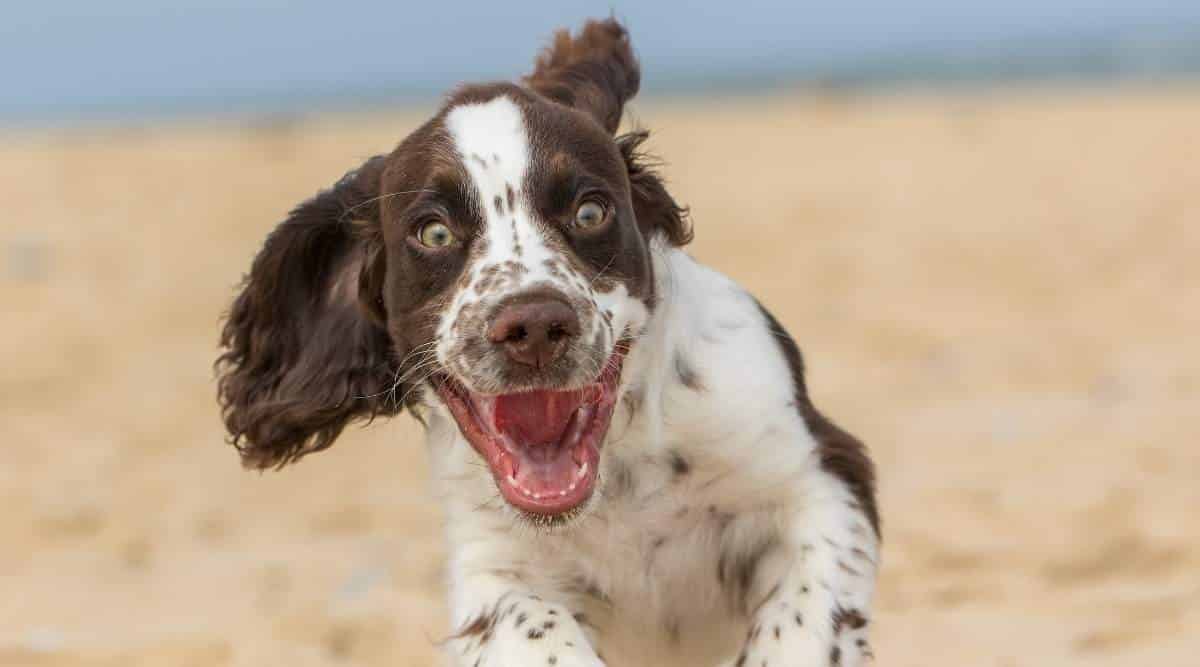Curly-Tail Breeds Uncovered: Traits, Care & Surprising Facts
When you purchase through links on our site, we may earn a commission. Here’s how it works.
Have you ever seen a dog tail that spirals like a cinnamon roll? Those curly little corkscrews aren’t just for show. Let’s unravel what those curly tails really say about your dog with our list of curly-tailed dog breeds.
Table of Contents
Curly Tails: Just Cute, Or Built For Survival?
Curly tails aren’t just for looks. In many breeds, that distinctive spiral serves a biological or functional purpose.
Notably, in Arctic breeds like Siberian Huskies, dogs use their curled tails to cover their noses while sleeping in freezing temperatures. It’s like a built-in blanket.
That said, some curly tails are purely the result of selective breeding. Humans often favor coiled tails for aesthetic reasons, especially in companion and toy breeds.
Our Favorite Breeds With Curly Tails
Some tails wag, some droop, and others spiral into tight little question marks over the back. From snow dogs to sofa loafers, these breeds all share one thing: a signature curl that’s impossible to ignore.
Below, we break down the most iconic curly-tailed dogs, what makes them unique, where they came from, and why that twist matters.
Arctic Powerhouses
These cold-weather champs don’t just survive in snow—they thrive in it. Their curled tails are more than decorative; they’re part of a centuries-old survival toolkit.
Siberian Husky
Siberian Huskies are athletic, social, and born to run. Originally bred by the Chukchi people of Siberia to pull sleds across vast frozen landscapes, these dogs are tireless and highly intelligent.
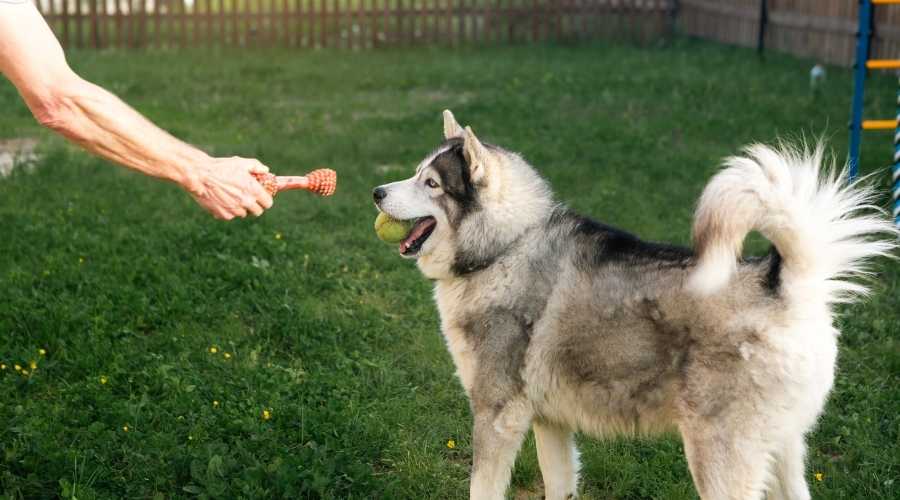
Their tails are medium-length, fluffy, and curve in a loose arc over the back, especially when the dog is alert or active. At rest or during sleep, many curl their tails over their noses to keep warm in subzero temperatures.
Huskies are notoriously independent and vocal. While friendly, they’re not ideal for first-time owners, especially without a secure yard and plenty of exercise.
- Tail Type: Loose plume curl
- Why It Matters: Used like a built-in nose cover to conserve heat in extreme cold
Alaskan Malamute
Larger and more powerful than the Husky, the Alaskan Malamute was built to haul heavy loads over long distances. These dogs have a strong pack mentality and thrive on structured activity.
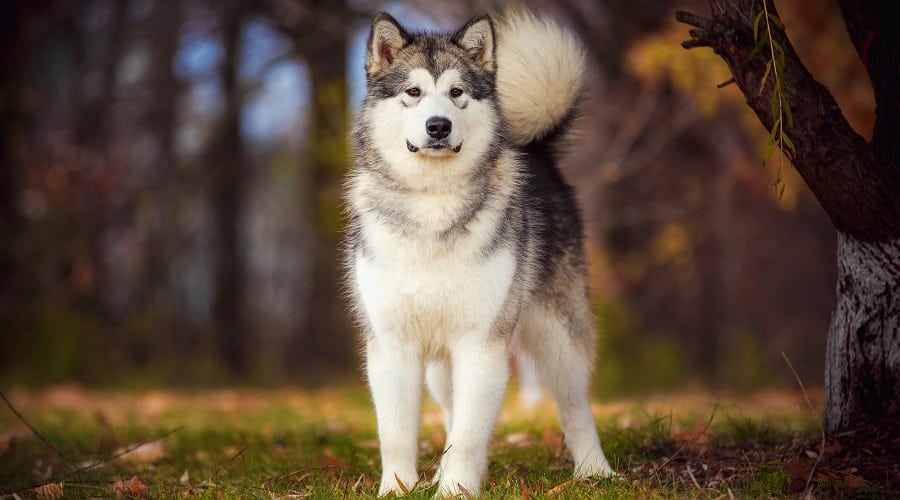
Their tails are thick and plume-like, curling upward and arching gently over the back. During frigid weather, Malamutes curl up with their tails covering their muzzles, creating a natural barrier against the cold.
Despite their working-dog toughness, Malamutes are gentle with people and deeply affectionate. However, they require experienced handlers and ample space to roam.
- Tail Type: Broad plume curl
- Why It Matters: Helps retain body heat while sleeping in snow
Samoyed
With a sparkling white coat and perpetual grin, the Samoyed is one of the most recognizable Arctic breeds. The Samoyedic people of Siberia developed these dogs to herd reindeer, haul sleds, and keep their humans warm at night.
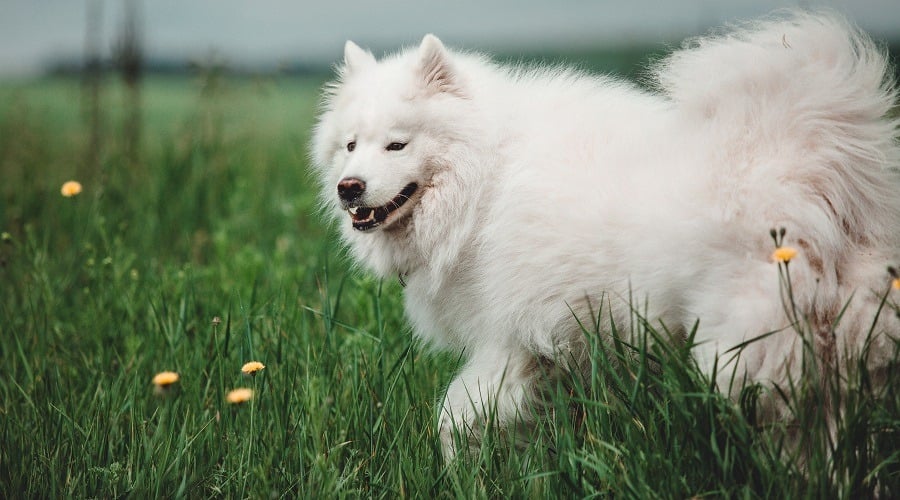
The tail is long, heavily furred, and curls tightly over the back. Samoyeds often tuck their tails around their faces while sleeping, helping to conserve warmth in harsh winter climates.
Samoyeds are highly social and form close bonds with their families. Without enough exercise or attention, they can become vocal and mischievous, so don’t be fooled by that sweet smile.
- Tail Type: Tight, fluffy plume curl
- Why It Matters: Acts as a natural insulator and cold barrier during sleep
Finnish Lapphund
Bred to herd reindeer in the icy north of Finland, the Finnish Lapphund is a calm, intelligent, and surprisingly agile breed. Their thick coats and bushy tails reflect generations of adaptation to freezing conditions.
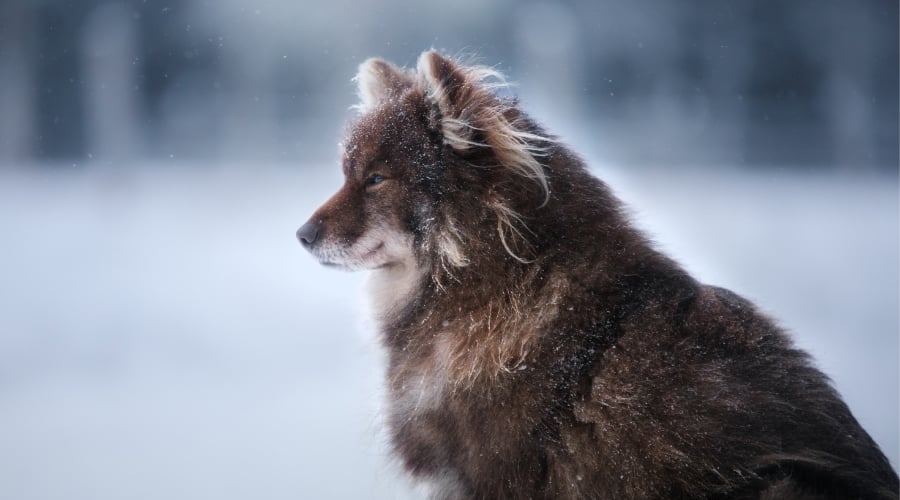
The tail curls in a loose arc and rests over the back, often blending seamlessly into the dog’s dense coat. When relaxed, it may drop down, but it lifts high when the dog is active or alert.
Friendly and easygoing, Finnish Lapphunds are a good fit for families and first-time owners. They’re also known for their expressive “talking” and gentle temperament.
- Tail Type: Loose brush curl
- Why It Matters: Tail curl reflects energy level and helps retain heat
Icelandic Sheepdog
The Icelandic Sheepdog is the island’s only native breed and a living link to the Viking era. Brought by Norse settlers over a thousand years ago, this spitz-type herder evolved to handle rough terrain, harsh weather, and independent work with livestock.
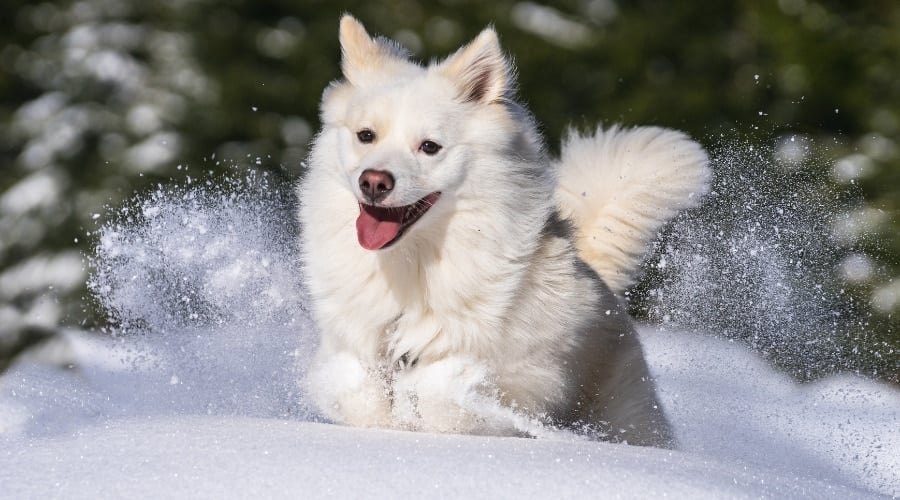
Its tail is classic Nordic: high-set, fluffy, and curled tightly over the back. Like other Arctic breeds, it often uses its tail to cover its nose while resting outdoors, conserving warmth in Iceland’s windy climate.
Bright, cheerful, and quick on its feet, the Icelandic Sheepdog is known for its vocal alerts and eager-to-please personality. It’s an affectionate companion but needs regular activity and a job to do—otherwise, you’ll hear about it.
- Tail Type: Tight, high plume curl
- Why It Matters: Helps retain heat and serves as a classic spitz trait used for weatherproof resting
Norwegian Elkhound
The Norwegian Elkhound is a rugged, spitz-type dog originally bred to track and hunt large game, such as elk and moose. With a fearless heart and sharp instincts, this breed is both courageous and loyal.
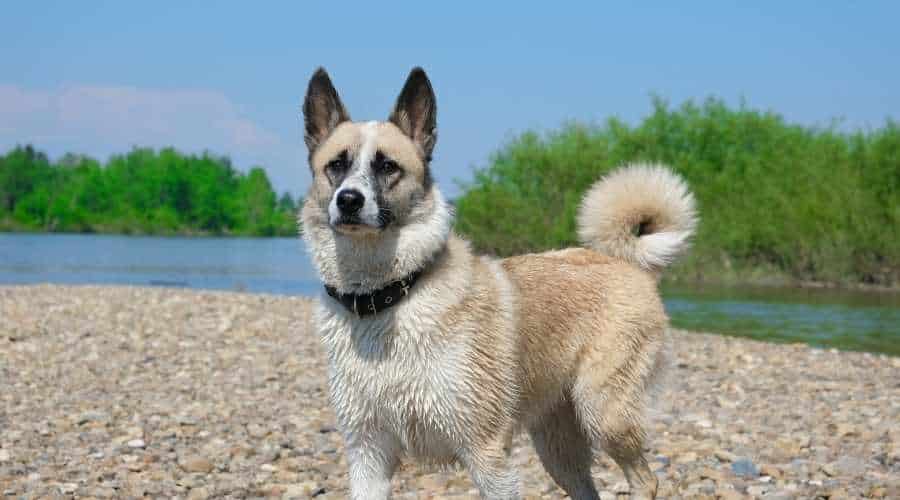
Its tightly curled tail sits high over the back, forming a distinctive loop common to many northern breeds. That curl helps keep body heat close when resting in cold weather.
Elkhounds are confident and energetic, with a strong protective streak. They do best with firm training, regular mental stimulation, and space to move.
- Tail Type: Tight single curl
- Why It Matters: Retains warmth and signals alertness in cold climates
Fluffy Show-Offs
Big coats. Bigger personalities. These breeds didn’t just get the curl; they got the styling to match.
American Eskimo Dog
Don’t let the name fool you; this breed originates from Germany, where it was previously known as the German Spitz. However, anti-German sentiment during World War I led to a rebranding of the breed.
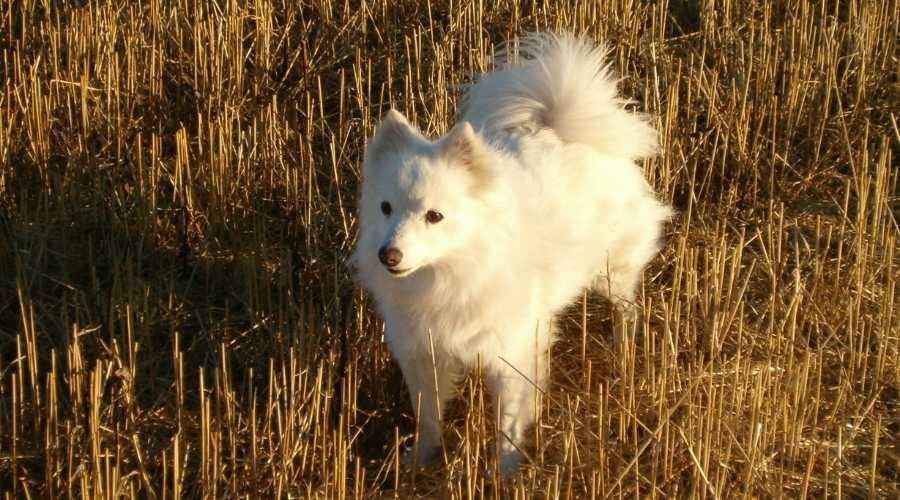
The American Eskimo Dog is playful, intelligent, and full of energy in a petite, polar-looking package.
Its curled tail is plume-like and rests high and proud over the back. When in motion, it flows like a feather duster, adding a touch of flair to every step.
Eskies come in toy, miniature, and standard sizes, but all require regular grooming and mental stimulation. Without it, they can quickly go from showy to shouty.
- Tail Type: High, flowing plume curl
- Why It Matters: Adds volume and visibility to a compact, expressive breed
Keeshond
Bred initially as a barge dog in the Netherlands, the Keeshond is a people-loving, medium-sized companion known for its cheerful smile and foxlike markings. It was once a symbol of Dutch patriotism during the 18th century’s political unrest.
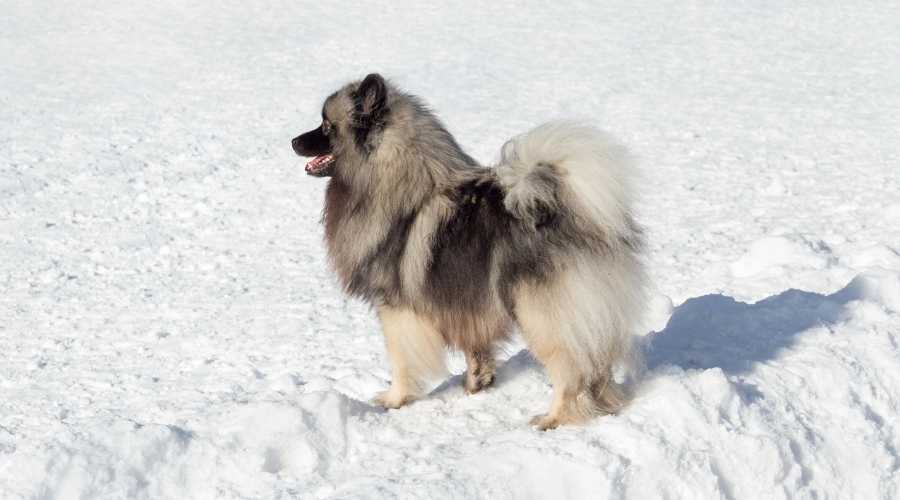
Its thick, bushy tail curls tightly over the back, often so seamlessly that it blends into the body fur. In motion, it gives the Keeshond a round, plush appearance.
Keeshonden are incredibly loyal and thrive on companionship. They’re alert but rarely aggressive, and their vocal tendencies make them excellent watchdogs—as long as you don’t mind the noise.
- Tail Type: Tight plume curl
- Why It Matters: Visually rounds out the breed’s signature puffball silhouette
Chow Chow
The Chow Chow is one of the oldest and most enigmatic dog breeds, hailing from ancient China. Known for their aloof demeanor and signature blue-black tongues, they’re dignified, powerful, and a little mysterious.
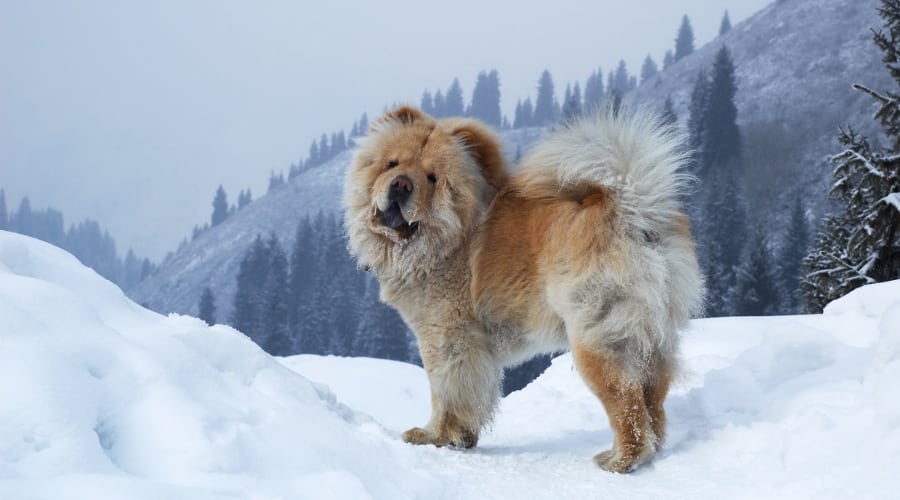
Their tails curl in a stiff arc over the back and are densely furred to match their lionlike manes. The tail doesn’t wag often—this is a breed that shows affection more subtly.
Chows are independent thinkers. While they’re loyal to their families, they can be standoffish with strangers and don’t tolerate rough handling. Socialization and structure are key from an early age.
- Tail Type: High, stiff curl
- Why It Matters: Reinforces the breed’s upright, regal posture and ancient spitz lineage
Pomeranian
Tiny body, massive tail, and an even bigger ego. The Pomeranian was once a 30-pound sled dog before being bred down into today’s feisty lap fluff.
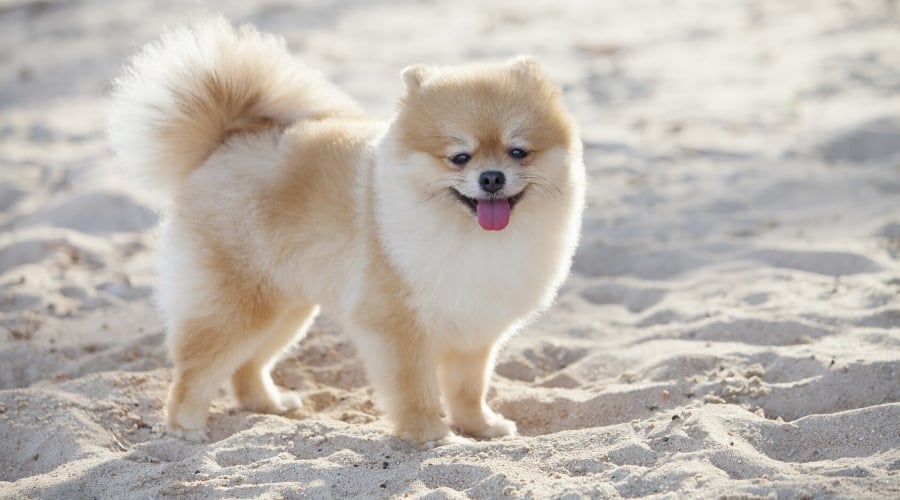
Its tail is one of the breed’s defining features—a high, curled plume that lays flat across the back and blends into the thick coat. When well-groomed, it creates a halo effect around the dog’s rear.
Despite their size, Poms are bold, vocal, and often convinced they’re in charge. They make charming companions but need firm, consistent training to match their oversized confidence.
- Tail Type: Flat-set plume curl
- Why It Matters: Aesthetic centerpiece that enhances the breed’s dramatic outline
Finnish Spitz
Nicknamed the “barking bird dog” in its native Finland, the Finnish Spitz is a lively hunting breed known for its yodel-like vocalizations. With a reddish-gold coat and perky ears, it often gets mistaken for a fox.
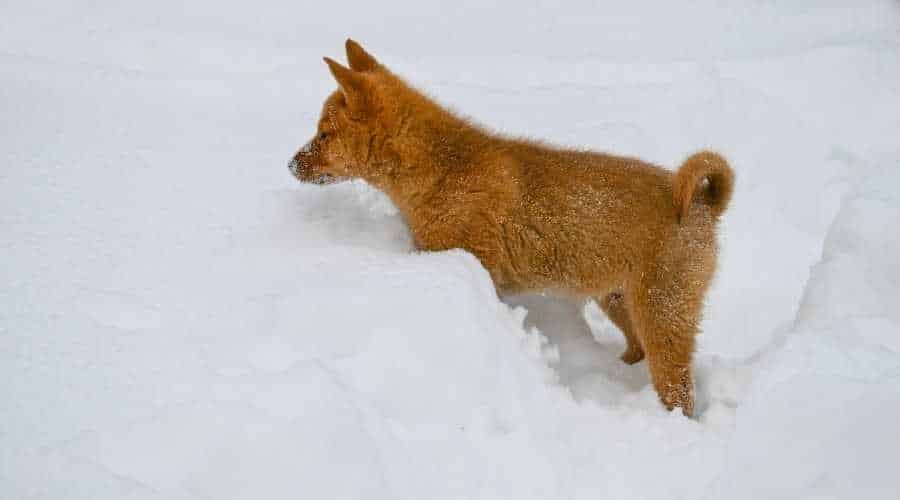
Its tail curls tightly over the back in a neat sickle shape, rising and resting high even when the dog is relaxed. The curl stays firm, echoing the dog’s confident carriage.
Finnish Spitzes are alert, energetic, and deeply devoted to their families. They do best in homes that appreciate both outdoor adventures and enthusiastic storytelling—vocalizations included.
- Tail Type: Tight brush curl
- Why It Matters: Reflects alertness and hunting readiness in classic Nordic style
Compact Twisters
They may be lap-sized, but their tails—and attitudes—are anything but small.
Pug
The Pug is one of the most iconic curly-tailed breeds, known for its wrinkled face, clownish charm, and deep loyalty. These dogs were once companions to Chinese emperors and later warmed the laps of European royals.

Its tail is famously curled—often into a double spiral over the back. In the show ring, the tighter the curl, the more it’s prized.
Pugs are affectionate, food-driven, and wonderfully stubborn. They thrive in apartment life but require care to avoid weight gain and overheating due to their short snouts.
- Tail Type: Tight double curl
- Why It Matters: Signature trait for the breed, but extreme curl can lead to spinal or nerve issues in some dogs
Basenji
This ancient African breed is best known for what it doesn’t do: bark. Instead, the Basenji produces a unique yodel-like sound called a “barroo.” It’s fast, clean, and packed with feline quirks.
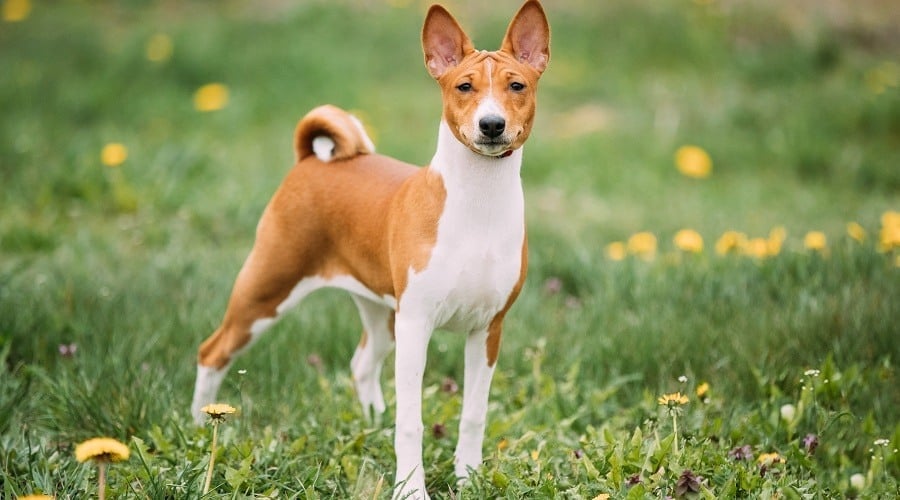
The tail is tightly curled and sits high over the back, often forming a neat loop. The curl reflects the breed’s alert, poised stance.
Basenjis are curious, energetic, and famously independent. They need a securely fenced yard, mental stimulation, and an owner who can handle their stubborn streak with humor.
- Tail Type: Tight single curl
- Why It Matters: Reinforces upright, agile posture and ancestral desert-breed silhouette
Shiba Inu
Japan’s most popular companion dog, the Shiba Inu is as independent as it is photogenic. With a confident gait, an expressive face, and a fox-like appearance, this breed has become a global internet favorite.
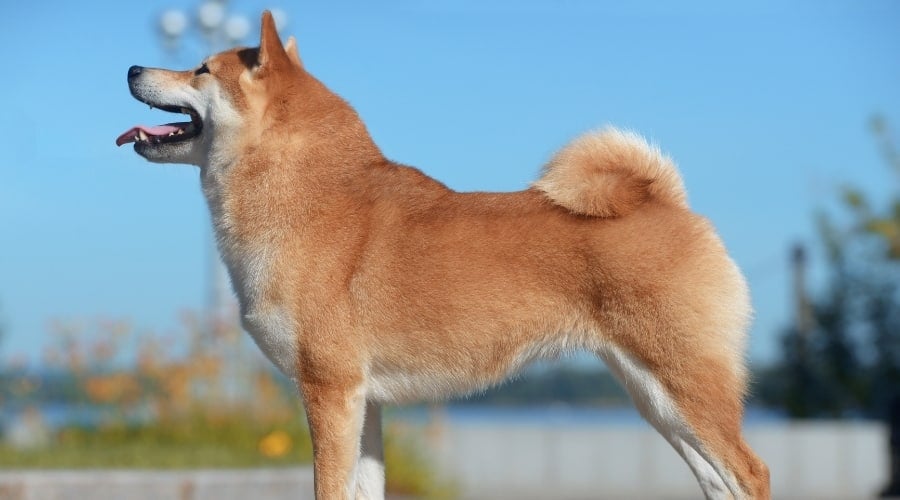
Its brushy tail curls tightly over the back in a firm arc, rarely wagging without reason. The curl is a signature feature and one of the breed’s key identifiers.
Shibas are known for being clean, clever, and stubborn. They bond strongly with their people but often prefer affection on their terms—and they’re known for their theatrical “Shiba scream” when displeased.
- Tail Type: Thick brush curl
- Why It Matters: Enhances the breed’s alert, upright frame and strong silhouette
Chihuahua
The Chihuahua combines a delicate frame with dramatic flair. These tiny dogs are famously loyal and often attach to one person with unmatched intensity.
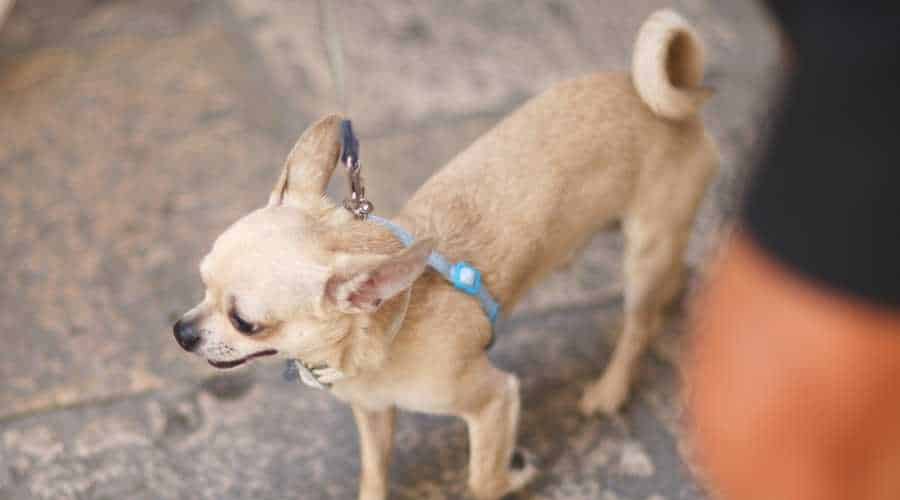
The tail varies in curl strength. Some have corkscrew tails, while others have straight tails.
Similarly, Long-haired Chihuahuas have tails that variy in curl strength but often arches high with feathered fur. When alert, the tail curves gracefully over the back like a banner.
Chihuahuas may be small, but they are bold, expressive, and surprisingly fearless. Their tail carriage often signals mood—from proud poise to full-body sass.
- Tail Type: Straight, corkscrew, or feathered curl
- Why It Matters: Decorative and expressive; not associated with spinal health risks, but feathering may require grooming attention
French Bulldog
French Bulldogs are best known for their bat ears and snorty charm. While most have naturally short, straight tails, some exhibit a mild screw tail—a low, tight curl caused by spinal anomalies.
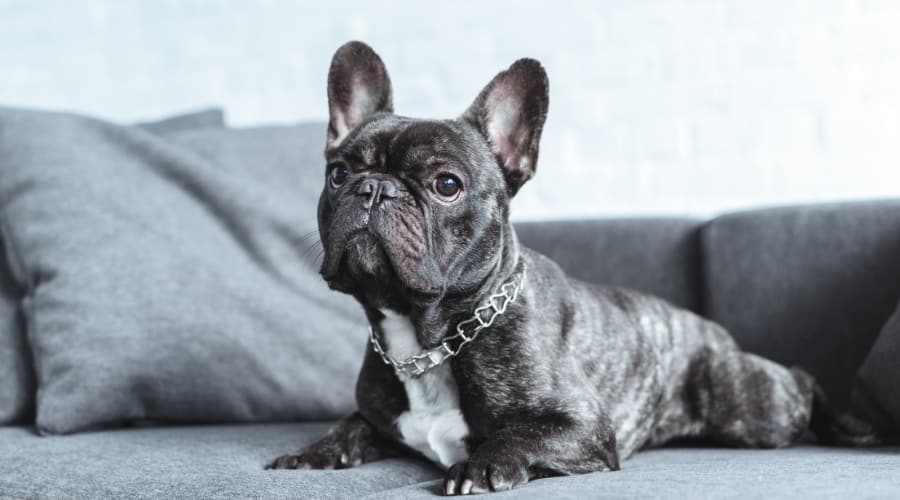
These tails don’t arch over the back like other breeds. Instead, they form a short spiral at the base, often hidden under thick rear muscles.
Because of their unique anatomy, Frenchies’ tails require close monitoring for skin issues or irritation. While not a traditional curled tail, it’s still a genetic twist worth noting.
- Tail Type: Low screw curl
- Why It Matters: Caused by hemivertebrae, which can lead to skin infections or spinal deformities; tail area should be regularly checked and cleaned
Boston Terrier
The Boston Terrier is a compact, tuxedo-coated breed with a cheerful personality and expressive eyes. Originally developed in the United States, it’s a cross between English Bulldogs and white English Terriers.

Most Boston Terriers have short, screw-shaped tails that are set low and do not curl over the back. The shape comes from abnormal vertebrae, and while small, the tail can still pose medical concerns.
Boston Terriers are generally low maintenance when it comes to grooming, but their tails should be checked for signs of infection, irritation, or spinal issues, especially in dogs with tightly twisted stubs.
- Tail Type: Low screw tail
- Why It Matters: Caused by vertebral anomalies that can contribute to discomfort or health issues if left unchecked
Stoic Guardians
These dogs are strong, self-assured, and often ancient in origin. Their curled tails aren’t just decorative—they’re signals of stature, confidence, and purpose.
Akita & American Akita
Originally bred in Japan to guard nobility and hunt large game, the Akita is a powerful, dignified breed with a deep sense of loyalty. The American Akita is slightly larger and more bear-like, but both share an aloof, protective temperament.

Their tails are thick and brushy, curling tightly over the back in a firm spiral. The curl adds to their upright posture and commanding presence.
Akitas are independent, quiet, and reserved with strangers. With proper training and early socialization, they form unshakable bonds with their families.
- Tail Type: High brush curl
- Why It Matters: Enhances the breed’s regal stance and reflects traditional Japanese spitz heritage
Tibetan Mastiff
This ancient guardian of Himalayan monasteries is renowned for its immense size, aloof demeanor, and lion-like mane. The Tibetan Mastiff was bred to protect livestock from predators at high altitudes.
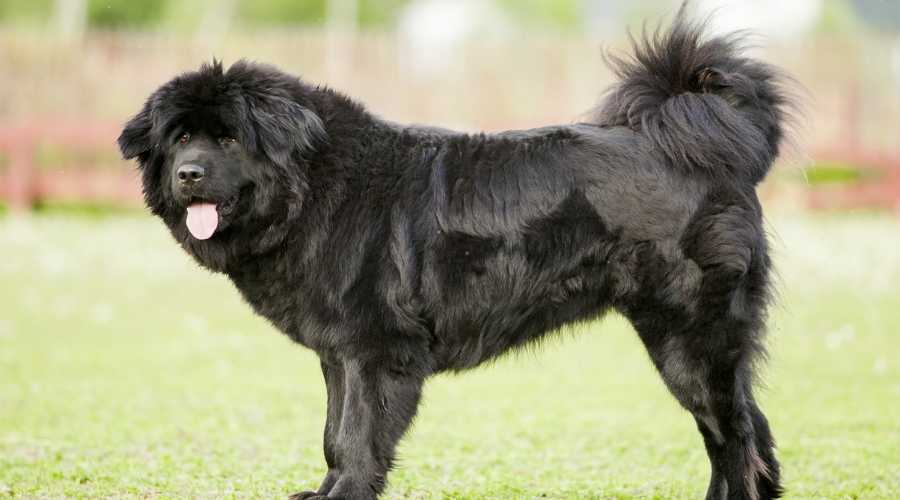
Its tail curls in a thick plume over the back, especially when the dog is alert. The curl adds balance and visual heft to its towering silhouette.
Tibetan Mastiffs are watchful and intensely territorial. They’re not a breed for casual pet ownership but can be incredibly loyal when raised in the right environment.
- Tail Type: Heavy plume curl
- Why It Matters: Balances the dog’s bulky frame and signals alertness in working posture
Norwegian Buhund
This agile and intelligent herder originates from coastal Norway and was once used by Vikings to guard farms and livestock. The Buhund is active, vocal, and highly trainable with the right guidance.
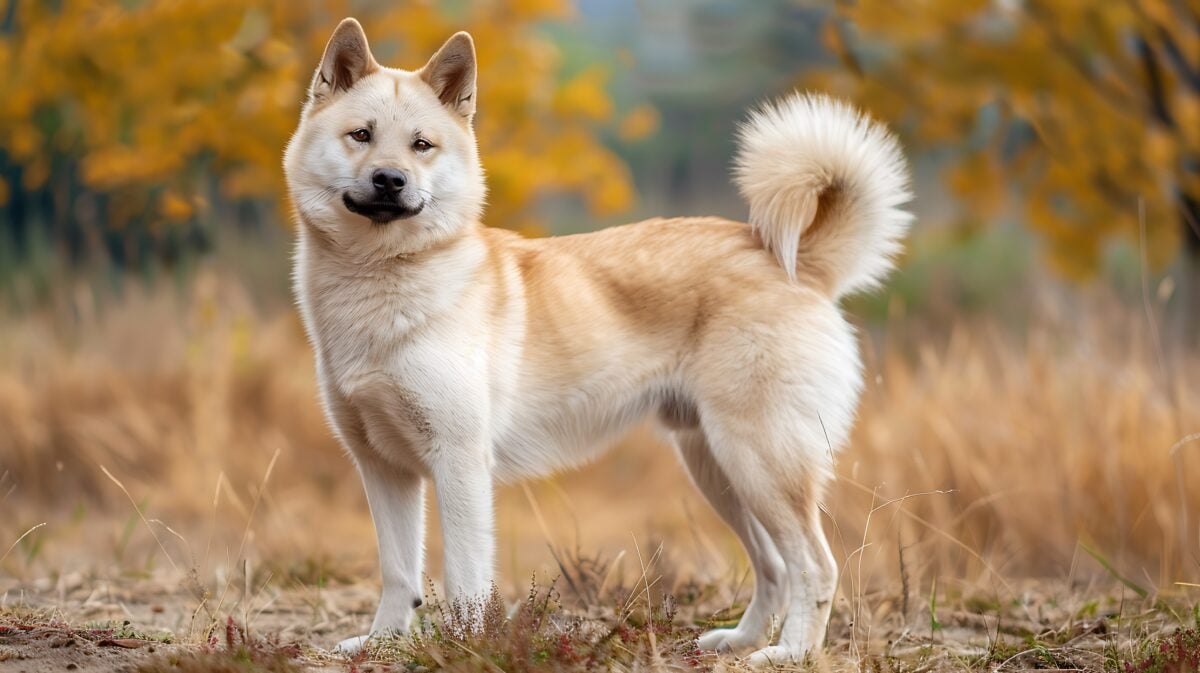
Its tail is tightly curled and held high over the back, giving the dog a springy, energized look. The curl is typical of Nordic spitz breeds and moves in sync with the dog’s sharp awareness.
Buhunds are affectionate and eager to work. They do best in homes where they have a job, whether it’s agility, obedience, or just helping herd the kids.
- Tail Type: Tight brush curl
- Why It Matters: Classic spitz-style tail that mirrors the breed’s alert, task-focused energy
Korean Jindo
The Jindo is a national treasure in South Korea, renowned for its bravery, loyalty, and cleanliness. Originally bred for hunting and guarding, it’s a medium-sized, independent dog with a strong prey drive.
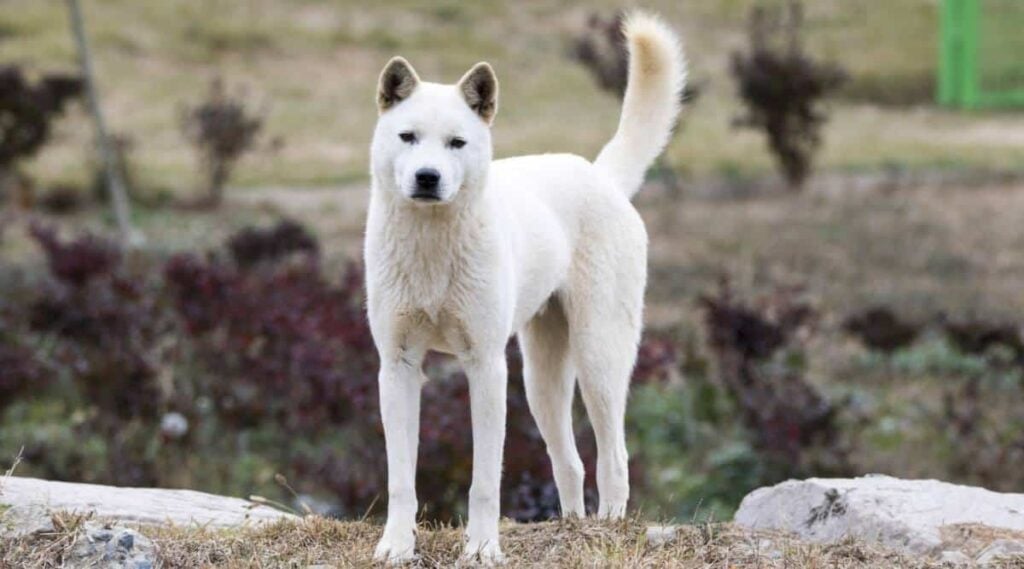
Jindos may have a sickle tail or a tightly curled brushtail; both are carried high over the back. The tail curl enhances their upright posture and natural wariness.
Jindos are deeply bonded to one person and known for escaping to return home across impossible distances. They thrive with confident, consistent leadership.
- Tail Type: High sickle or brush curl
- Why It Matters: A culturally symbolic trait that reflects vigilance and independence
English Bulldog
English Bulldogs are known for their stout build, loose skin, and distinctive faces, but their tails deserve attention too. Many Bulldogs have short, tightly coiled tails, often formed due to spinal deformities.
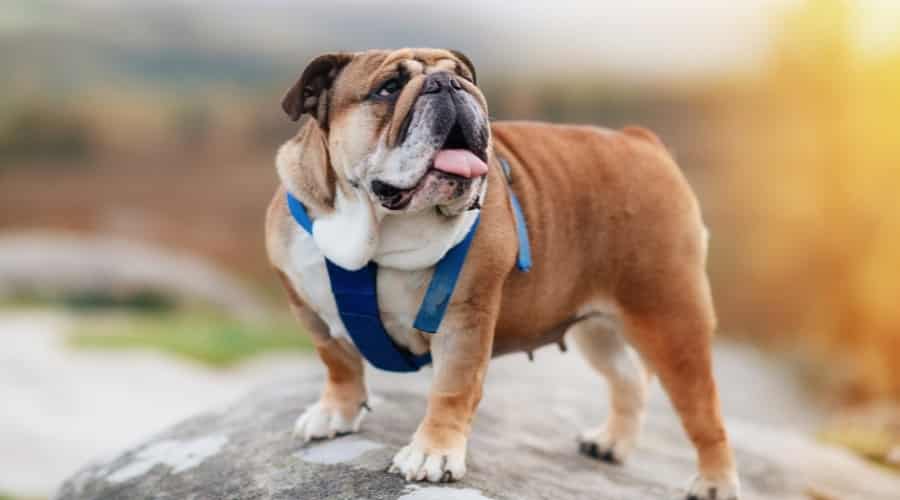
These “screw tails” don’t curl over the back like spitz breeds. Instead, they form a tight spiral near the rump, often nestled between skin folds.
Because of the breed’s screw tail, they can be prone to skin infections, restricted movement, or in some cases, spinal problems. Regular cleaning and monitoring are essential.
- Tail Type: Low screw curl
- Why It Matters: Formed by spinal malformation; may lead to health concerns if not properly managed
The Science Behind The Swirl
So, what actually makes a tail curl? In some breeds, it starts in the bones.
Dogs with screw or corkscrew tails, like Pugs and Bulldogs, often have a spinal condition known as hemivertebrae.
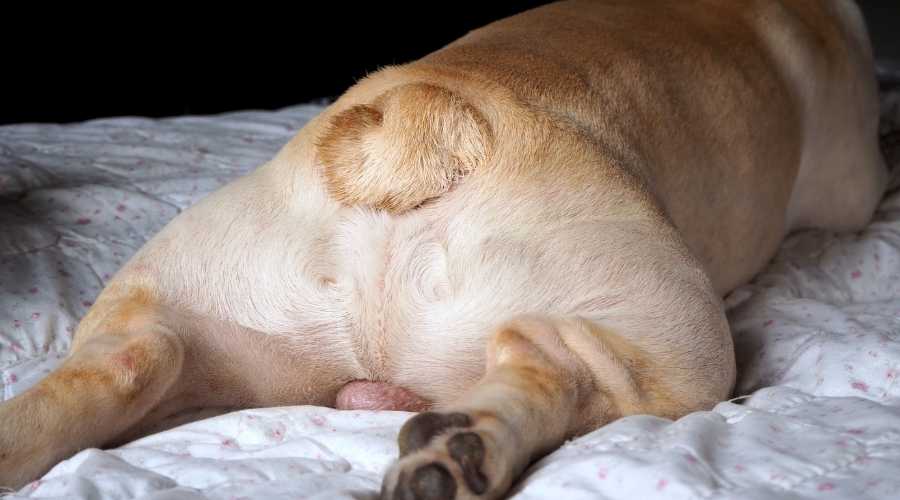
Instead of forming in smooth, stackable shapes, the tail bones grow wedge-shaped or fused. This creates a tight spiral, similar to stacking doorstops instead of bricks.
Hemivertebrae is common in these breeds and usually harmless when limited to the tail. In more severe cases, it can affect other parts of the spine and lead to mobility or neurological issues.
However, not all curly tails are caused by skeletal deformities.
Breeds like Shiba Inus, Akitas, and many spitz-types have sickle-shaped tails. These tails curl over the back due to genetics and soft tissue structure, not malformed vertebrae.
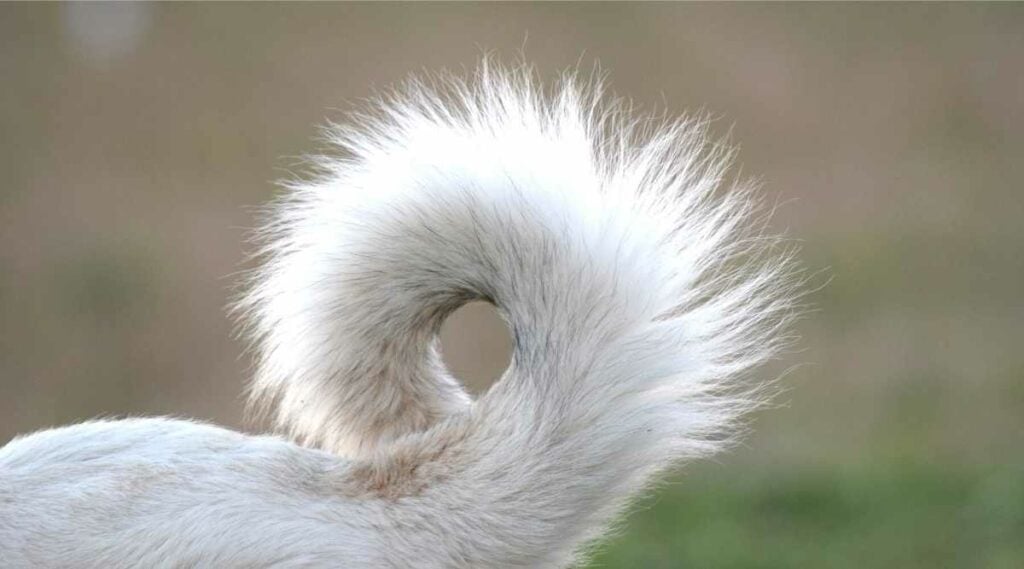
Curly tails are often categorized by how much they curl. Pugs may have a double spiral, while Shibas carry a firm single arc. The shape depends on both bone structure and surrounding ligaments and muscles.
Researchers have begun identifying the genes involved in tail development. One study published in PLOS Genetics linked vertebral segmentation mutations to tail deformities in some breeds.
Quick Takeaway: How Tail Curl Happens
- Hemivertebrae are wedge-shaped spinal bones that curve the tail
- These are inherited and most common in curly- or screw-tailed breeds
- Tail curl can range from a loose arc to a full spiral, depending on bone shape
- In rare cases, spinal deformities extend beyond the tail and may affect mobility
Tail Tales Through History
Curly tails didn’t happen by accident. For many dog breeds, that spiral carries centuries of meaning: spiritual, practical, and even political.
In Japan, the Akita’s curled tail was once seen as a symbol of strength and loyalty.
Statues of Akitas with their signature tails are still given as gifts to honor courage, especially in times of hardship. The famous dog Hachikō, remembered for waiting years at a train station after his owner’s death, was an Akita whose curled tail became part of his enduring silhouette.
For Arctic sled dogs, curled tails weren’t just about looks; they were survival tools.
Siberian Huskies and Malamutes curled up with their tails over their noses while resting in subzero temperatures, conserving body heat and reducing frostbite risk. Without those tails, some early sled dogs couldn’t endure the cold.
Even in companion breeds, tail shape wasn’t random. The Pug’s double curl was a sign of refinement in 18th-century Europe. Chinese breeders considered the tightness of the curl a mark of quality, and early art often depicted royals with Pugs curled beside them like ornamental pillows.
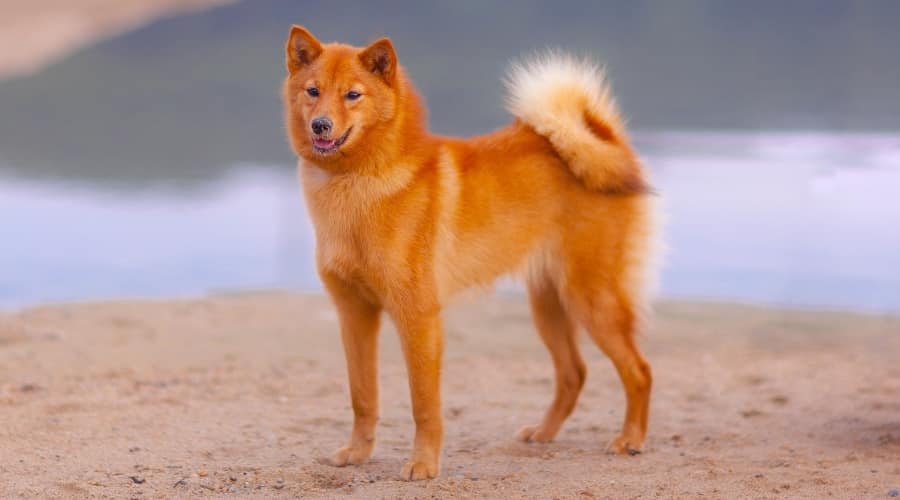
In many spitz-type breeds, curled tails became functional identity markers. They made it easier to spot the dog in snow or brush, and the tight posture of the tail often indicated alertness, stamina, and good breeding.
Today, those same spirals still carry significance, whether it’s a built-in scarf, a royal signature, or a tail that tells a thousand years of history in a single loop.
Frequently Asked Question
You’ve seen the spirals, the fluff, and the function. Now, let’s answer some of the most common (and curious) questions dog owners have about curly tails.
Don’t see your question? Ask us in the comments!
Can A Curly Tail Straighten Out?
Sometimes. Puppies may have looser tails that curl more tightly as they mature. In adult dogs, a tail that suddenly droops or uncurls could signal injury, illness, or stress.
Are Curly Tails Genetic Or Learned?
They’re genetic. Curly tails come from the shape of the tail vertebrae, which are often wedge-shaped and naturally create a curve. Training or behavior won’t change the tail structure.
Do Curly Tail Dog Breeds Have Back Problems?
They can, but not always. Breeds with screw tails, like Bulldogs and French Bulldogs, are more likely to experience spinal issues. Spitz-type breeds typically carry their curl without problems.
Why Don’t All Dogs Have Curly Tails?
Tail shape varies by breed function. Sighthounds, for example, have long, straight tails that help with speed and balance. Curly tails are more common in breeds developed for cold climates or companionship.
Do Curly Tails Affect A Dog’s Movement?
Usually not. Most dogs with curled tails can move, run, and jump without any issue. Only extremely malformed tails may limit motion.
Is It True That Tail Position Shows A Dog’s Mood?
Yes. High and curled usually signals confidence or alertness, while a dropped or limp tail may show fear, submission, or discomfort—even in breeds that usually carry their tails high.
Can You Tell Breed Purity By Tail Shape?
Sometimes. A perfectly curled tail is part of the breed standard for dogs like Pugs, Shiba Inus, and Akitas. However, tail shape alone isn’t a reliable indicator of breed purity.
More About Your Dog’s Tail
Curious about what else your dog’s tail might be saying? Learn more about the meaning behind different wagging styles or find out whether tail-chasing is normal, instinctual, or something to stop. You can also explore the history and controversy surrounding dog tail docking.



